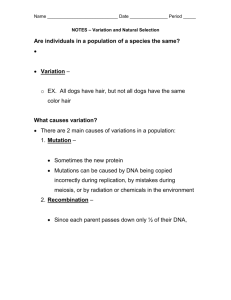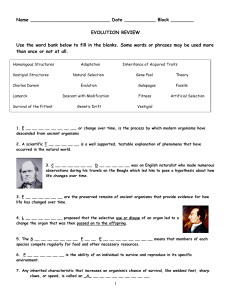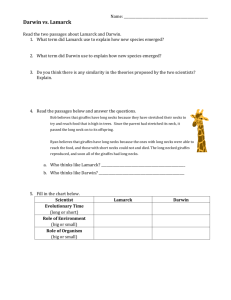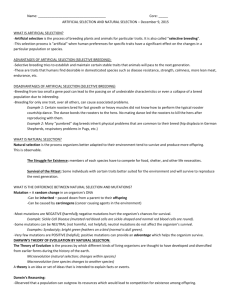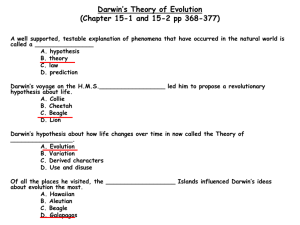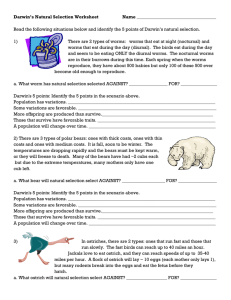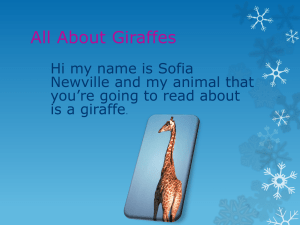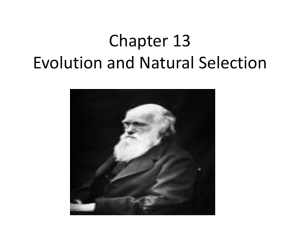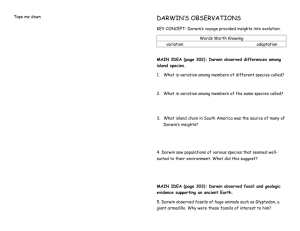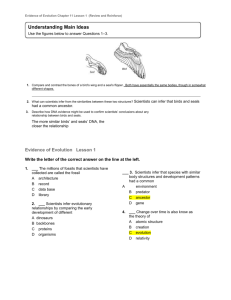Theory of Evolution Directed Reading
advertisement
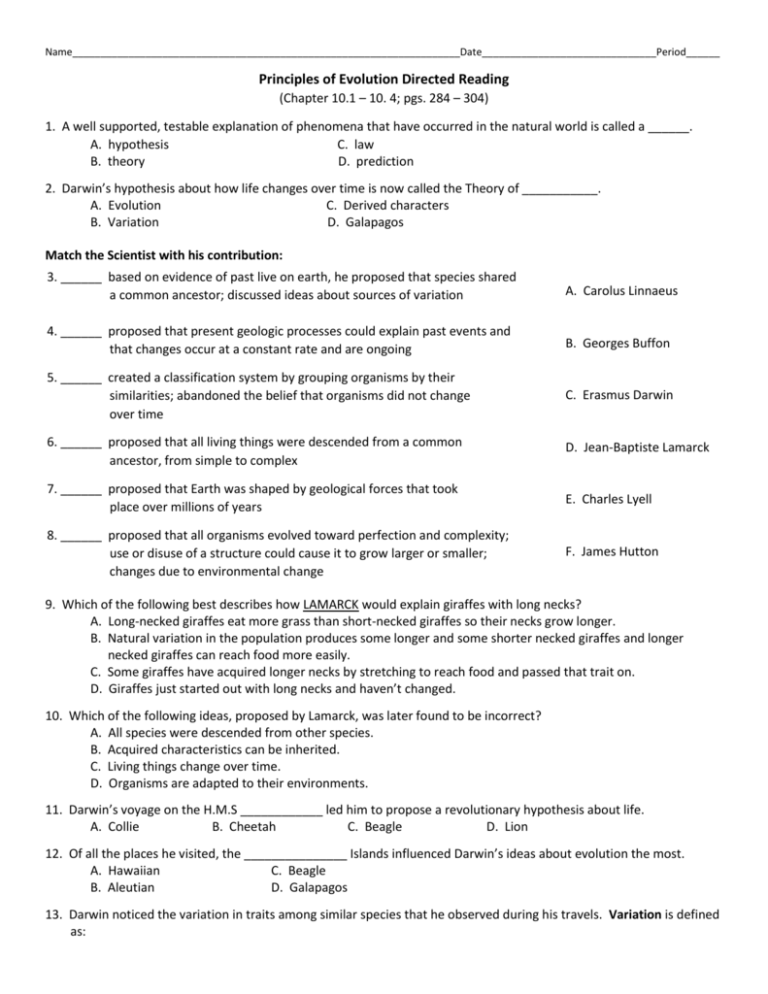
Name_____________________________________________________________________Date_______________________________Period______ Principles of Evolution Directed Reading (Chapter 10.1 – 10. 4; pgs. 284 – 304) 1. A well supported, testable explanation of phenomena that have occurred in the natural world is called a ______. A. hypothesis C. law B. theory D. prediction 2. Darwin’s hypothesis about how life changes over time is now called the Theory of ___________. A. Evolution C. Derived characters B. Variation D. Galapagos Match the Scientist with his contribution: 3. ______ based on evidence of past live on earth, he proposed that species shared a common ancestor; discussed ideas about sources of variation A. Carolus Linnaeus 4. ______ proposed that present geologic processes could explain past events and that changes occur at a constant rate and are ongoing B. Georges Buffon 5. ______ created a classification system by grouping organisms by their similarities; abandoned the belief that organisms did not change over time C. Erasmus Darwin 6. ______ proposed that all living things were descended from a common ancestor, from simple to complex D. Jean-Baptiste Lamarck 7. ______ proposed that Earth was shaped by geological forces that took place over millions of years E. Charles Lyell 8. ______ proposed that all organisms evolved toward perfection and complexity; use or disuse of a structure could cause it to grow larger or smaller; changes due to environmental change F. James Hutton 9. Which of the following best describes how LAMARCK would explain giraffes with long necks? A. Long-necked giraffes eat more grass than short-necked giraffes so their necks grow longer. B. Natural variation in the population produces some longer and some shorter necked giraffes and longer necked giraffes can reach food more easily. C. Some giraffes have acquired longer necks by stretching to reach food and passed that trait on. D. Giraffes just started out with long necks and haven’t changed. 10. Which of the following ideas, proposed by Lamarck, was later found to be incorrect? A. All species were descended from other species. B. Acquired characteristics can be inherited. C. Living things change over time. D. Organisms are adapted to their environments. 11. Darwin’s voyage on the H.M.S ____________ led him to propose a revolutionary hypothesis about life. A. Collie B. Cheetah C. Beagle D. Lion 12. Of all the places he visited, the _______________ Islands influenced Darwin’s ideas about evolution the most. A. Hawaiian C. Beagle B. Aleutian D. Galapagos 13. Darwin noticed the variation in traits among similar species that he observed during his travels. Variation is defined as: 14. On these islands, Darwin observed that the characteristics of many animals and plants ____________. A. all looked alike B. varied from island to island C. were acquired through use 15. Explain how the tortoises varied from island to island. Include the saddle-backed tortoises, domed tortoises, and the climates/environments of the islands they were found on. 16. On the Galapagos Islands, Darwin discovered birds with differently shaped beaks. What might this tell you about the eating habits of the birds on the different islands? Explain your answer. 17. In addition to living organisms, Darwin studied the preserved remains of ancient organisms called ________. A. fossils C. adaptations B. homologous structures D. vestigial organs 18. Because of its similarities to artificial selection, Darwin referred to “survival of the fittest” as _________. A. use it or lose it C. homologous structures B. natural selection D. struggle for existence 19. The natural differences between individuals of a species are referred to as _____________. A. fitness C. adaptations B. natural selection D. natural variation 20. When farmers select the largest hogs, the fastest horses, or the cows that produce the most milk for breeding it is called ____________. A. natural selection C. survival of the fittest B. artificial selection D. homologous variation 21. The idea that each living species has descended with changes from other species over time is called _________. A. descent with modification C. artificial selection B. struggle for existence D. acquired traits 22. An inherited characteristic that increases an organism’s ability to survive and reproduce in its specific environment is called a(n) __________. A. homologous structure B. vestigial organ C. adaptation D. speciation 23. Which of the following best describes how DARWIN would explain giraffes with long necks? A. Long-necked giraffes eat more grass than short-necked giraffes so their necks grow longer. B. Natural variation in the population produces some longer and some shorter necked giraffes, and longer necked giraffes can reach food more easily and survive to pass on their genes. C. Some giraffes have acquired longer necks by stretching to reach food and passed on that trait. D. Giraffes just started out with long necks and haven’t changed. 24. The ability of an individual to survive and reproduce in a specific environment is called __________. A. fitness C. survival of the fittest B. common descent D. struggle for existence 25. All of the following play a role in Darwin’s Theory of Evolution EXCEPT ___________. A. natural variation C. struggle for existence B. survival of the fittest D. inheritance of acquired traits 26. Name 7 kinds of evidence that support Darwin’s Theory of Evolution.
